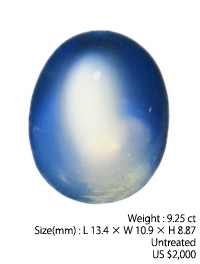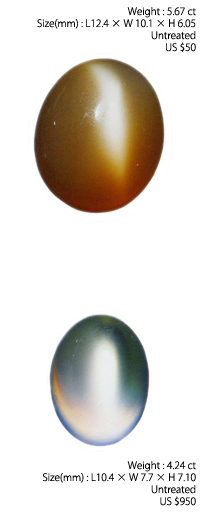VARIETIES OF
MOONSTONE
Moonstone occurs in a wide range of bodycolors including colorless, grayish blue, slightly bluish green, yellowish green, light orange, and orangery brown. The moonstone effect (adularescence) appears according to each color. Here we weill discuss blue moonstone from Sri Lanka, orange moonstone from India, and rainbow moonstone (labradorite) from India. Moonstone is also found in Myanmar. |
 |
Blue Moonstone
Sri Lankan material is clear and colorless and displays a milky bluish band of light. Large material exceeding 10 carats has been produced, but currently most stones are smaller ones of about 2 carats. Material with an especially strong blue, called “Royal Blue Moonstone,” is highly valued. |
|
Orange Moonstone
Among the material that is mined in the state of Madras in India, there is the somewhat brownish orange moonstone as shown in the photograph. The hue is orange, but there is a range of tones centering on the light colors. Grayish blue, bluish green, and yellowish green moonstones are also mined in India. There are all considered to have about the same value. |
 |
Rainbow Moonstone
India is also the source of the rainbow moonstone seen in the photograph. Production is extremely limited, and some are priced even higher than the blue moonstone found in Sri Lanka. Mineralogically speaking, rainbow moonstone is labradorite feldspar. |
|
 |
JUDGING QUALITY
The basic key to judging quality in moonstone is the bluish band of milky light (adularescence of sheen). Fine material has a distinct sheen, and as the viewing angle of the stone is changed, the sheen moves smoothly across the stone. When considering a stone for use in jewelry, the outline, profile, and height of the cabochon are important quality factors.
Tone cannot be incorporated into the quality scale for moonstone. This is because moonstone does not vary into any specific hue from colorless (or white). In this way it differs from materials like diamond, which gradually ranges from colorless to yellow.
The beauty grade can be thought of in exactly the same manner as any other gemstone. Transparency, saturation of color (gray, green, brown), cut (shape, proportion, finish), and eye-visible inclusions (especially cleavage) are collectively judged first. The moonstone effect (adularescence) is then taken into consideration and a beauty grade is decided upon. In this book, Sri Lankan material has been assigned beauty grades S and A based on its beauty and transparency, and top-quality Indian material has been assigned grade B. However, even in Sri Lankan stones, low-quality material will be lower than grade B. Grades S and A are gem quality, grade B is jewelry quality, and grades C and D become accessory quality. Interestingly, when moonstone is placed on top of a metal surface, light in the stone increases, and its beauty is multiplied. Therefore it is important to remember that moonstone that has been made into jewelry will be much more attractive than loose material.
|
| |
|